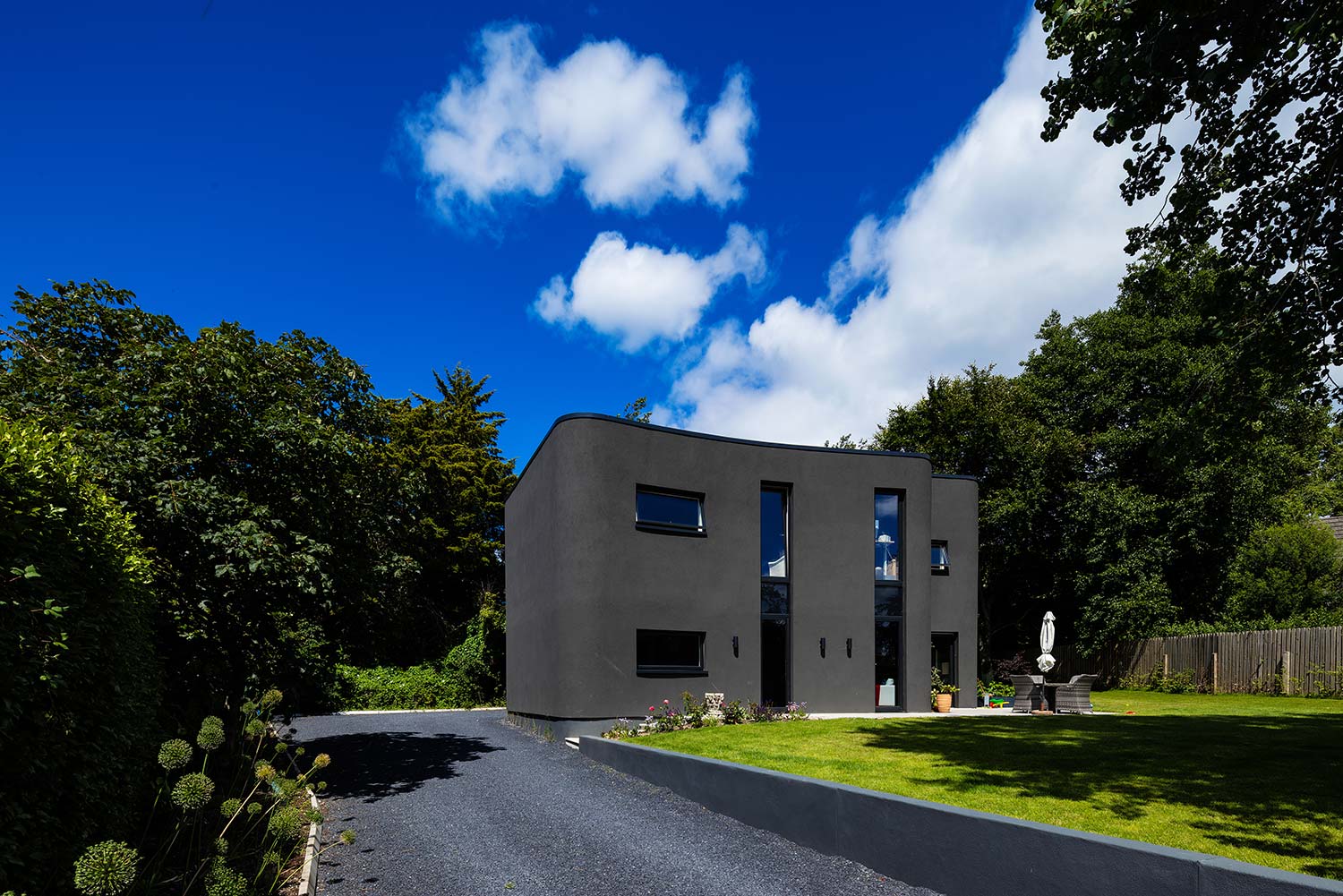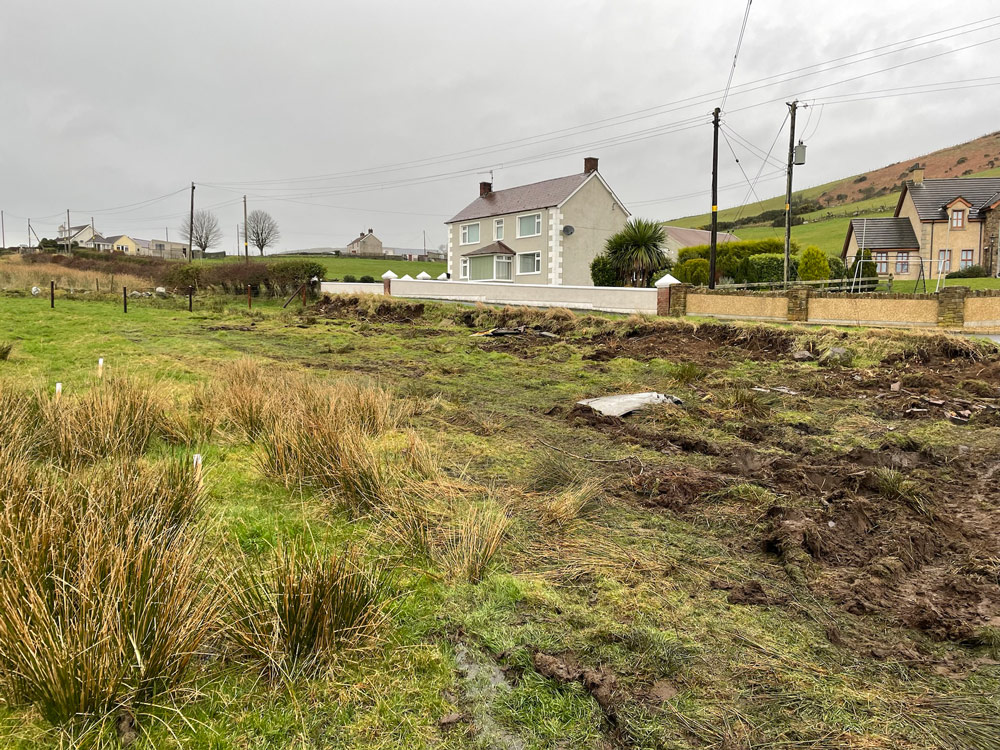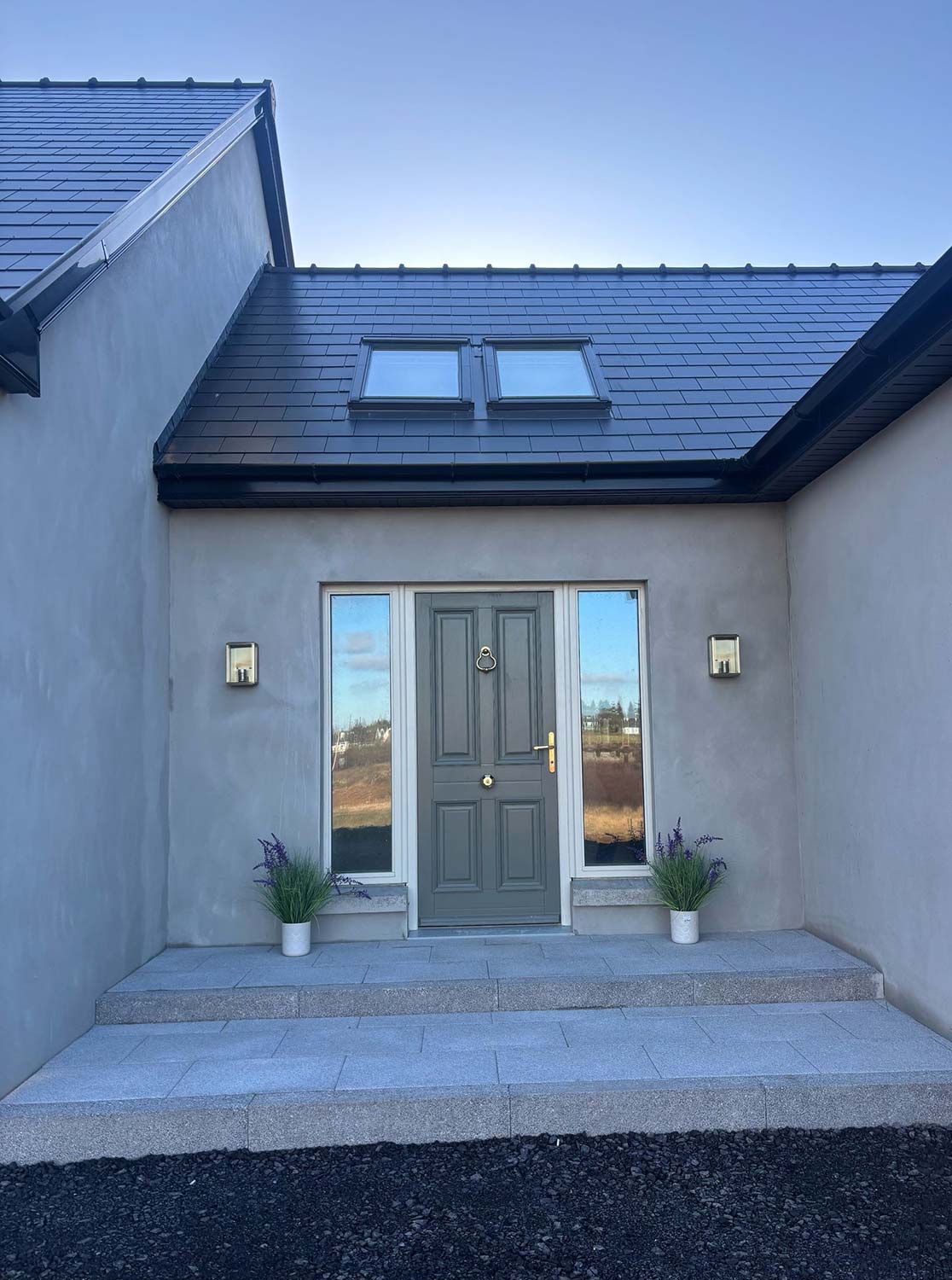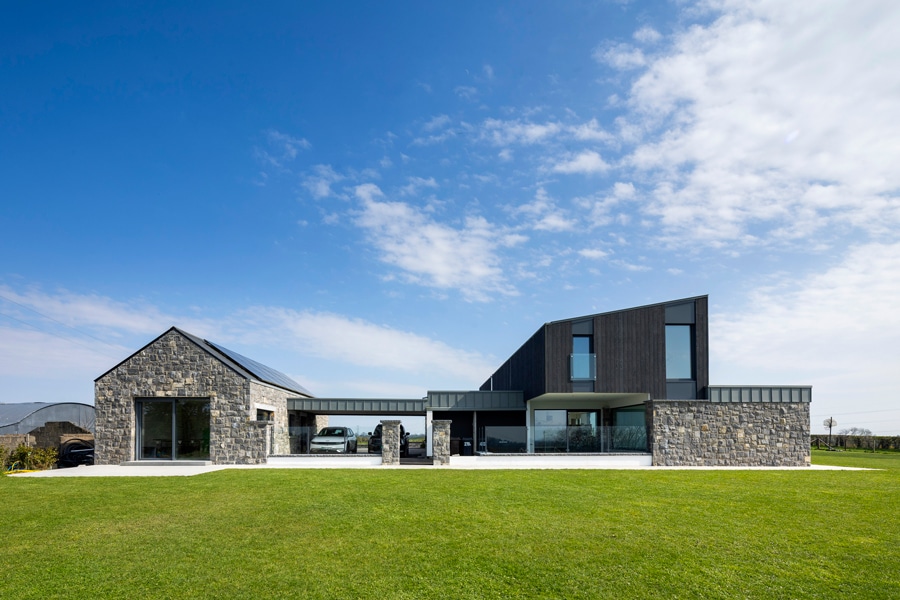.
Construction work must be done in accordance with the current statutory (mandatory) regulations: Planning Regulations, Building Control Regulations (which include the Building Regulations), and Health & Safety Regulations. The Republic of Ireland (ROI) and Northern Ireland (NI) each have their own sets of regulations.
The first statutory requirement when building a house is to secure planning permission. You must submit your full house plans to your local authority (city or county council) for approval. This involves a fee and paperwork. Some extensions are exempt from applying for planning permission, as are most renovation projects. Listed buildings often require planning permission for all type of work on them. Check with your local authority if you are exempt before proceeding with any work with what’s known as a Section 5 Declaration in ROI or a Certificate of Lawful Development in NI.
Once the plans have been approved, they must be converted to construction drawings that comply with the Building Regulations, whether or not you had to get planning permission. The Building Regulations are there to ensure the house you build, extend or significantly renovate, is built to a safe standard, is accessible, and is energy efficient. Building Control regulations enforce that the Building Regulations are put into practice.
Health and safety (H&S) regulations, meanwhile, are there to ensure that the building site is a low risk environment for persons doing work or supervising it, and for those supplying materials or equipment.
Planning Regulations ROI
When building in the countryside, the applicable zoning laws for your area are contained within the County Development Plans (CDPs). These are updated periodically, usually every six years. There are plans to have the CDPs across all local authorities to be valid for the same period of time.
Cities and towns will have a Local Area Plan. Zoning relates to what areas the council deems acceptable for what type of development, and under what conditions. Rural Design Guides are often issued by local authorities, often within the CDP as is the case for Donegal, Meath or Laois for example. The first council to publish a design guide, to great acclaim, was Cork County Council. These guidelines will give you an indication of what type of house and finishes are acceptable to the planners.
The application fee for building a house is €65, and €34 for an extension.
Once your application is approved, the council will ask that you pay a development levy (known as a contribution) before starting work on the house; this amount can be considerable (thousands of euros) and will vary depending on the local authority, the size of your house, and where you are building exactly. Ask your local authority at the planning application stage how much your levy will be.
Tipperary County Council has published a cluster housing policy document in December 2018, which indicates new one-off houses in the countryside should be built in a group, wherever possible.
An excellent overview of planning legislation and guidelines are available from the Office of the Planning Regulator here.
The list of CDPs are below along with some of the Rural Design Guides which are design guidelines for one-off houses in the countryside.
Carlow County Council (2022-2028)
Carlow Rural Design Guide (2021)
Cavan County Council (2022-2028)
Cavan Rural Design Guide (2011)
Clare County Council (2023-2029)
Clare Rural Design Guide (2005 – Second edition)
Cork County Council (2022-2028)
Cork Rural Design Guide (2010 – Second edition)
Donegal County Council (2024-2030)
Donegal Rural Design Guide (2012)
Dún Laoghaire-Rathdown (2022-2028)
Fingal County Council (2023-2029)
Galway County Council (2022-2028)
Galway Rural Design Guide (2005)
Kerry County Council (2022-2028)
Kerry Rural Design Guide (2009)
Kildare County Council (2023-2029)
Kildare Rural Design Guide (2017)
Kilkenny County Council (2021-2027)
Kilkenny Rural Design Guide (2008)
Laois County Council (2021-2027)
Laois Rural Design Guide (2022)
Leitrim County Council (2023-2029)
Leitrim Rural Design Guide (2024)
Longford County Council (2021-2027)
Longford Rural Design Guide (2019)
Louth County Council (2021-2027)
Mayo County Council (2022-2028)
Mayo Rural Design Guide (2008)
Meath County Council (2021-2027)
Meath Rural Design Guide (2009)
Monaghan County Council (2025-2031)
Monaghan Rural Design Guide (2008)
Monaghan Draft Design Guide (2008)
Offaly County Council (2021-2027)
Offaly County Council Designing Houses Creating Homes (2008)
Roscommon County Council (2022-2028)
Roscommon Rural Design Guide (2018)
Sligo County Council (2024-2030)
South Dublin County Council (2022-2028)
Tipperary County Council (2022-2028)
Tipperary Rural Design Guide (2022)
Westmeath County Council (2021-2027)
Westmeath Rural House Design Guidelines (2005)
Wexford County Council (2022-2028)
Wicklow County Council (2022-2028)
Limerick City and County Council (2022-2028)
Limerick Rural Design Guide (2012)
Waterford City and County Council (2022-2028)
Dublin City Council (2022-2028)
Cork City Council (2022-2028)
Galway City Council (2023-2029)
Planning Regulations NI
As of April 2015, a two-tiered planning system was introduced. Since then, each district council became a local planning authority with the Department for Infrastructure as the regional planning authority. There are 11 local authorities in NI.
This has led to each council having to come up with its own set of rules to grant planning permission, in the form of Local Development Plans, leading to an unequal and unfair situation, according to pundits.
Some councils have not yet implemented new development plans and the old system is still in place, as contained within PPS21: Sustainable Development in the Countryside (June 2010).
Guiding the assessment of PPS21 applications will include other policy documents, namely the Regional Development Strategy (RDS) 2035, Strategic Planning Policy Statement (SPPS) (2015) and PPS3: Access, Movement and parking (2005 / 2006). You must also consult any relevant area plans (spatial policy), and policies in relation to your site if it is located in an Area of Outstanding Natural Beauty or in a Conservation Area.
For guidance on what the planners think is suitable to build in the countryside, consult the supplementary design guide called Building on Tradition. A Sustainable Design Guide for the Northern Ireland Countryside (2012).
Planning application fees for building a new home is £515 and for an extension, £347. Full description of fees as of April 1, 2025 are on page 9 of the Department of Infrastructure’s Explanatory Notes for Applicants.
ROI Building Control Regulations
The Building Control Regulations (1997-2020) provide the legal basis for enforcing the building regulations and your obligations as a homeowner. ROI’s 31 Local Authorities are designated as Building Control Authorities under the Building Control Acts 1990 to 2014.
You will file all documents related to building control online, including declaring whether you wish to opt in our out of appointing an Assigned Certifier and filing your Commencement Notice (which costs €30), on the Building Control Management System. You must set up an account; how to videos are available here and an overview of the process (FAQs) here. Contact details for building control officers in local authorities is available here (dated 2017).
For sample inspection schedules, the Code of Practice for Inspecting and Certifying Buildings and Works (2016) is an excellent guide.
ROI Building Regulations
Part of the Building Control Regulations are the Building Regulations. The technical guidance documents (TGD) are the reference documents to consult, as published by the Department of Housing, Planning and Local Government. These refer to established standards and protocols.
Part A: Structure (2012 edition)
Part B: Fire (2017 edition) with supplementary guidance
Part C: Site preparation and resistance to moisture (2023 amendment)
Part D: Materials and workmanship (2013 edition); for nonstandard products Agrément Certificates can be found on the National Standards Authority of Ireland (NSAI) website
Part E: Sound (2014 edition)
Part F: Ventilation (2019 edition); check the NSAI website for independent third party ventilation certifiers
Part G: Hygiene (2008 edition, reprint 2011) for bathrooms, kitchens and washing facilities
Part H: Drainage and waste water disposal (2010 edition, reprint 2016) including the NSAI’s S.R. 66:2015 in compliance with the EN 12566 series of standards. For details on what types of onsite wastewater treatment systems are possible, consult the Environmental Protection Agency’s Code of Practice: Wastewater Treatment Systems for Single Houses (2021).
SR 66 specifies the design capacity for a dwelling based on the number of bedrooms rather than size. Scaling rules for increasing the plant size but maintaining the performance have also been introduced. Part H of the Building Regulations has been amended to make these requirements mandatory. Although many of the products on the market already comply to these requirements, some may not, so always check that the system you choose is fully compliant to the current regulations, which also include abiding to the EN 12566 standard and to the Environmental Protection Agency Code of Practice 2009. A regular maintenance regime will be put in place with your chosen supplier to ensure the system works as intended over time.
The EPA’s Remediation and Replacement of Domestic Waste Water Treatment Systems (2021) provides guidance notes on the remediation and replacement of domestic wastewater treatment systems.
Part J: Heat producing appliances (2014 edition) for the safe combustion of fuel, and fuel storage
Part K: Stairways, ladders, ramps and guards (2014 edition)
Part L: Conservation of fuel and energy in dwellings (2022); check the NSAI website for cavity wall and external wall certified installers and for airtightness installers
Part M: Access and use (2022); also consult guidance from the Centre for Excellence in Universal Design
NI Building Control Regulations
As per the Building Regulations (NI) Order 1979, the Department of Finance and Personnel (DFP) is responsible for the development and the implementation of policy and legislation relating to the Building Regulations for Northern Ireland. Building Control Northern Ireland is a voluntary umbrella grouping of the Building Control Departments of the eleven local councils.
You must submit an application with your local authority’s Building Control Department if you are building or extending, but also if you are upgrading any aspect that relates to the Building Regulations, e.g. upgrading the insulation in your home, changing your central heating, changes to mains powered smoke detectors, etc.
There are two types of applications: the Full Plans Application (required for a new house) and Building Notice Application (used for extensions less than 10sqm in floor area, converting a loft within a dwelling if less than 3sqm in floor area, etc.).
Contact the Building Control Service in the first instance to get the application form and guidance on the process. Application forms for each of the councils are listed below.
Antrim and Newtownabbey Borough Council
Ards and North Down Borough Council
Armagh City, Banbridge and Craigavon Borough Council
Causeway Coast and Glens Borough Council
Derry City and Strabane District Council
Fermanagh and Omagh District Council
Lisburn and Castlereagh City Council
Mid and East Antrim Borough Council
Newry, Mourne and Down District Council
Fees are payable on submission of applications and subsequent inspections of the work, as one-off payments. Under the Building Notice system, the plan and inspection fee are combined and are payable once the application is submitted. The lowest fees are for houses less than 250sqm in internal floor area; £121.50 to get the construction drawings approved, then £283.50 for the inspection fee (covers multiple inspections). In small extensions under 20m2, the plan fee also covers any and all inspections subsequently carried out on site. Full details are available here.
More on Building Control fees from BCNI here.
NI Building Regulations
The Technical Booklets are the reference documents to consult, as published by the Department of Finance and Personnel. These refer to established standards and protocols.
Technical Booklet B: Materials and workmanship (2013 edition) with amendments from 2022 here
Technical Booklet C: Site preparation and resistance to moisture (2012 edition) with amendments from 2022 here
Technical Booklet D: Structure (2012 edition)
Technical Booklet E: Fire safety (2012 edition) with amendments from 2022 here and from 2025 here
Technical Booklet F1: Conservation of fuel and power (2022 edition)
Technical Booklet G: Resistance of the passage of sound (2012 edition)
Technical Booklet H: Stairs, ramps, guarding and protection from impact (2012 edition)
Technical Booklet J: Solid waste in buildings (2012 edition)
Technical Booklet K: Ventilation (2012 edition) which refers to the Domestic Ventilation Compliance Guide for best practice guidelines.
Technical Booklet L: Combustion appliances and fuel storage systems (2012 edition)
Technical Booklet M: Physical infrastructure for high-speed electronic communications networks (2017 edition)
Technical Booklet N: Drainage (2012 edition)
Technical Booklet P: Sanitary appliances, unvented hot water storage systems and reducing the risk of scalding (2012 edition)
Technical Booklet R: Access to and use of buildings (2012 edition) with amendments from 2025 here and from 2022 here
Technical Booklet V: Glazing (2012 edition)
ROI Health & Safety Regulations
The Health and Safety Authority has published a Guide for Homeowners (2013) outlining your obligations in relation to appointing a Project Supervisor Design Stage and a Project Supervisor Construction Stage. These relate to the Safety, Health and Welfare at Work (Construction) Regulations 2013. For a list of what risks and measures will need to put in place, consult the BeSMART.ie website. More on the duty holders on a construction site here.
Further reading: Guidelines on the Procurement, Design and Management Requirements of the Safety health and Welfare at Work (Construction) Regulations 2013 (Updated 2017)
NI Health & Safety Regulations
The Construction (Design and Management) Regulations (Northern Ireland) 2016 require that you notify the health and safety authorities of your project starting, with an NI10 form, unless you carry out all the work yourself, in which case the project is classed as DIY and CDM 2016 does not apply.
For a guide to CMD for self-builders, check out National Custom and Self Build Association’s guide.
Domestic clients are people who have construction work carried out on their own home (or the home of a family member) that is not done as part of a business. CDM 2016 applies if the work is carried out by someone else on the domestic client’s behalf.
The homeowner’s client duties are normally transferred to: the contractor for single contractor projects or the principal contractor for projects with more than one contractor. However, the domestic client can instead choose to have a written agreement with the principal designer to carry out the client duties.
More on H&S in construction here.




















